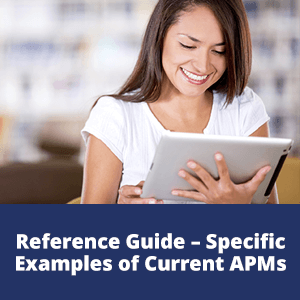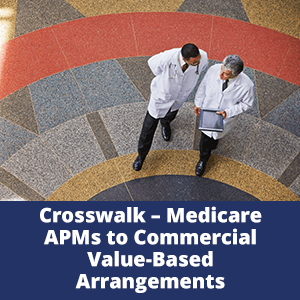Value-Based Arrangement Resources
The Physician’s Advocacy Institute has partnered with Healthsperien, a health care consulting firm based in Washington, D.C., to develop a comprehensive set of value-based arrangement resources to help physicians better understand and assess the pathways available to their practices and utilize the learnings toward successful participation in appropriate value-based arrangements.
Value-based arrangements are a concept by which purchasers of health care (i.e., payers, employers, and consumers) hold the health care delivery system at large (physicians and other providers, hospitals, etc.) accountable for both quality and cost. The aim is to promote enhanced population health management, resulting in the improvement of a patient’s health outcome and systemic cost containment or reduction. Value-based arrangements (i.e., value-based contacting) use alternative payment models (APMs) to create a combination of incentives and disincentives to encourage better health care decision making by linking compensation to specific performance measures.
The following topics have been carefully selected to provide critical details on APM practice participation. A description of each resource is provided below:

Introduction
Determine whether an APM is the appropriate pathway for you
Learn More

Practice Assessment
Core care management techniques, data insights, and risk-based APMs
Learn More

Reference Guide – Specific Examples of Current APMs
Comparison of key attributes across APMs
Learn More

Evaluating Patient Risk and Physician Performance in APMS
Critically evaluate risk in your patient panel
Learn More

Practice Structuring for APM Participation
How your practice can operate under multiple APMs
Learn More

Crosswalk – Medicare APMs to Commercial Value-Based Arrangements
How quality can be linked to payment
Learn More

Types of Value-Based Revenue Models
Model participation based on practice structure and capabilities
Learn More

Guide to Value-Based Contracting
Tips for when contracting with different entities
Learn More
This document provides considerations in determining whether an APM is the appropriate pathway for you and/or your practice that include (1) understanding how performance is measured under different APMs; (2) evaluating your current practice operations and ability to access and analyze data; (3) understanding your patient population; (4) what it means to take on financial risk in APMs; and (5) decoding risk adjustment. A decision to seek participation in an APM requires a broad assessment of the potential costs, risks, and rewards to your practice.
Building on the introductory document above, this resource provides an overview of the interactions between core care management techniques, data insights, and additional details on what it means to engage in risk-based APMs. Furthermore, this document dives deeper into value-based arrangements and highlights the types of variables and rules to be attuned to for specific APMs.
The Center for Medicare and Medicaid Innovation (CMMI) currently operates 43 APMs across a variety of categories. These include episodic-based payment initiatives, primary care transformation, and accountable care. This document compares key attributes (e.g., participant eligibility, patient eligibility, payment, etc.) across a variety of APMs including Primary Care First, Primary Care First Seriously Ill Population, Comprehensive Primary Care Plus, and Direct Contracting.
This document is intended to help physicians understand how to critically evaluate risk in their APM patient panel. The concept of “risk” is more than recognizing the potential for and magnitude of financial losses but is a broader understanding of the underlying variables that positively or negatively impact performance in APMs that can change from year-to-year. Under APMs, physicians are financially responsible for the efficiency and quality of care provided to their patient panel, with the potential for financial rewards or losses depending on performance.
Beyond the complexities of choosing which model to participate in, this resource provides guidance on how physicians and/or practices can operate under multiple APMs, the numerous CMS/CMMI rules regarding model overlaps, and the various options for tax identification number (TIN) structuring in APMs to participate in multiple models..
This resource provides guidance on how meeting certain quality outcomes can be linked to various types of APM payment mechanisms under different models. Medicare Advanced APMs are payment models that allow physicians and practices to be eligible to earn a 5% incentive payment (i.e., bonus) for taking on some financial risk related to patients’ quality outcomes and costs. The five percent incentive payment is separate and distinct from the payments for services received through the Advanced APM, such as model-specific rewards. The attributes of the Advanced APMs detailed in this guide can be referenced to better understand commercial, Medicaid, and all-payer value-based payment arrangements.
This document provides guidance on how physicians and/or practices can make an informed decision on which value-based revenue (VBR) Models to participate in based on practice structure, analytic capabilities, and appetite for varying levels of risk taking. There are several types of VBR models available to physicians and physician groups, depending on their risk tolerance level and which model(s) work best for their practice structure. This document covers each VBR model available in detail, as well as some of the potential benefits or drawbacks of participation in each model type.
To improve odds of success in value-based APMs, value-based contracting and negotiations are fundamental to ensuring APM contracts are favorable to physicians and practices. This document covers the three types of entities physicians will likely contract with: health plans, Accountable Care Organizations (ACOs), and Direct Contracting (DC) with employers. This document provides guidance on what you and your practice should be aware of when engaging in contracting with these entities and how to use this information to help your practice during the negotiation process.